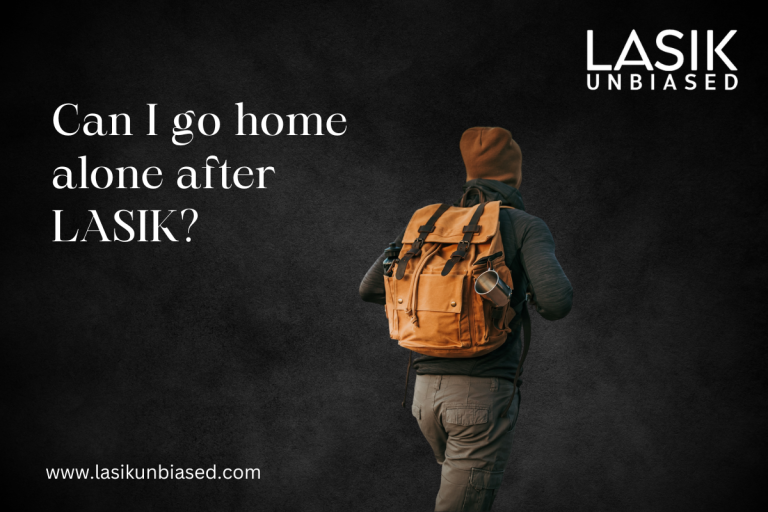LASIK surgery is a popular procedure that offers clear vision without needing glasses or contact lenses. The procedure is quick and painless, with most patients completing their surgery in under 30 minutes.
While the recovery process is generally smooth, one of the most critical questions is whether a patient can go home alone after LASIK. Although the procedure does not require hospitalization, post-surgery vision may be temporarily blurry, making independent travel unsafe immediately after the surgery.
Immediate Effects After LASIK
Right after LASIK surgery, the eyes need time to adjust and begin the healing process. Since numbing eye drops are used during the procedure, patients do not experience pain. Still, they may feel discomfort, light sensitivity, or a sensation of dryness once the anaesthesia wears off. These side effects are temporary, but they can make it difficult to focus on objects clearly for the first few hours after surgery.
Blurry vision is shared in the initial recovery phase. While some patients notice an improvement in their vision almost immediately, it takes time for the cornea to stabilize fully. Because of this, navigating alone, especially in bright light or on busy streets, is not recommended immediately after LASIK.
Why You Should Not Go Home Alone
One of the primary reasons patients should not go home alone after LASIK is the temporary vision changes that occur right after the procedure. These changes can make walking long distances, crossing streets, or navigating public transportation unsafe. Even for those who feel confident about their mobility, the discomfort and sensitivity to light can make the journey home challenging.
Driving is strictly prohibited immediately after LASIK. Since vision remains unstable and reaction times may be slower, vehicle operating can be dangerous. For this reason, patients are advised to arrange for a friend, family member, or car service to drive them home safely.
Besides vision concerns, LASIK patients may also feel fatigued after the procedure. Though LASIK does not involve general anaesthesia, the stress of undergoing eye surgery can cause mild exhaustion. Having a companion ensures the patient gets home safely and can rest comfortably without additional strain.
Safe Transportation Options After LASIK
The safest way to get home after LASIK is to have a trusted friend or family member accompany the patient. If this is not an option, pre-arranging a taxi or ride-sharing service is a good alternative. However, patients should avoid travelling alone via public transportation, as bright lights and crowded spaces can overwhelm sensitive eyes.
Wearing sunglasses can help reduce light sensitivity while travelling. Doctors often recommend wearing a pair of dark, UV-protected sunglasses immediately after the procedure. This precaution helps shield the eyes from harsh sunlight and artificial lights, making the journey home more comfortable.
The First Few Hours of Recovery
Once home, patients should rest their eyes as much as possible. Avoiding screen time, bright lights, and reading helps reduce strain. Eye drops prescribed by the doctor should be used as directed to prevent dryness and irritation. Most patients find that taking a short nap makes their eyes feel more comfortable and refreshed.
Since vision remains slightly blurry for the first few hours, it is best to have someone available to assist with essential tasks. While most patients can function independently by the next day, having a support system ensures a smoother recovery process.
When Can You Go Out Alone Again?
Most LASIK patients can resume activities, including going out alone, within 24 to 48 hours. However, this depends on individual healing progress and doctor recommendations. The first follow-up appointment, usually scheduled within a day or two after surgery, allows the doctor to assess vision and confirm whether driving or going out alone is safe.
Waiting at least 24 hours is advisable for those who rely on public transportation or need to walk long distances. If the eyes still feel sensitive or vision is not yet stable, waiting an extra day before venturing alone is the best approach.
Long-Term Vision Stability
While vision improves rapidly in the first few days after LASIK, complete stabilization takes a few weeks. During this time, it is important to follow post-operative care instructions, including using prescribed eye drops, avoiding rubbing the eyes, and protecting them from excessive sunlight and dust.
By the end of the first week, most patients feel completely comfortable moving around independently. Those with jobs that require extensive screen use or outdoor exposure should take extra precautions to prevent eye strain and dryness.
Going home alone immediately after LASIK is not recommended due to temporary vision changes and sensitivity. Having a trusted companion or arranging for safe transportation ensures a smooth and comfortable journey home. While most patients recover quickly, resting the eyes and following post-operative care guidelines help speed healing. Within a day or two, patients can resume their daily activities, including going out alone, with confidence in their improved vision.


